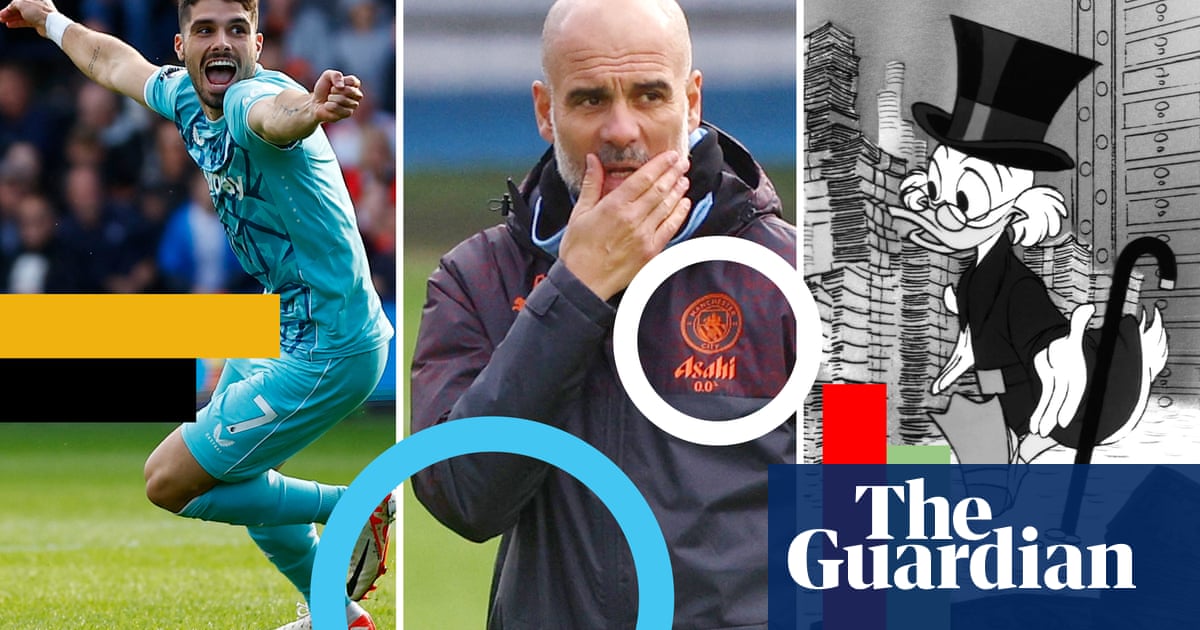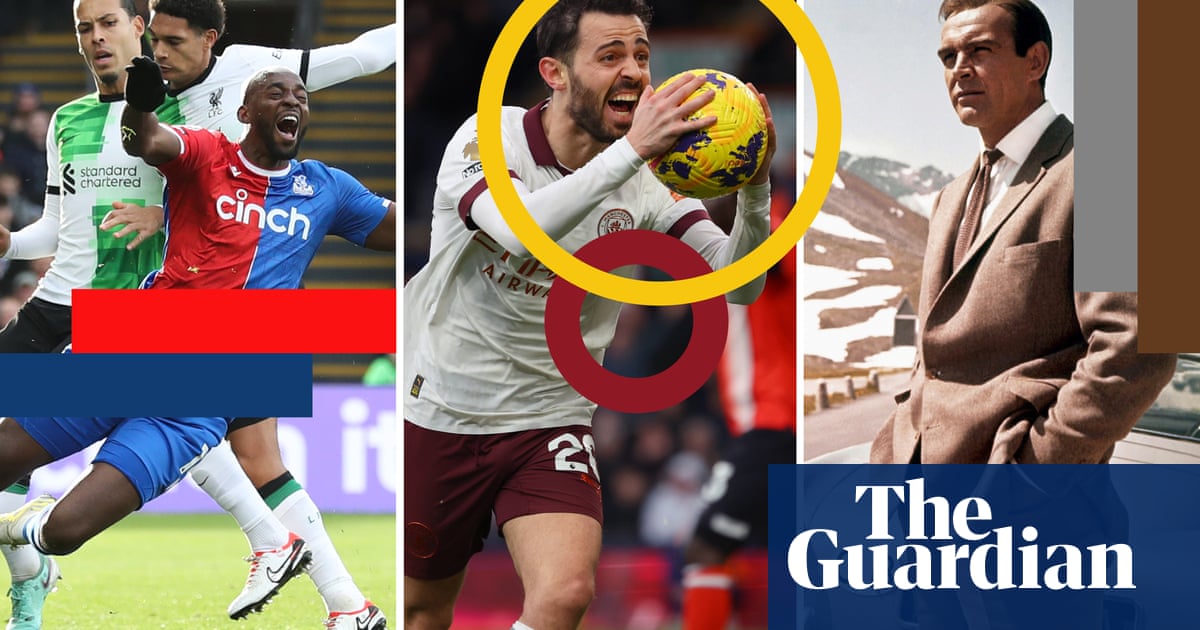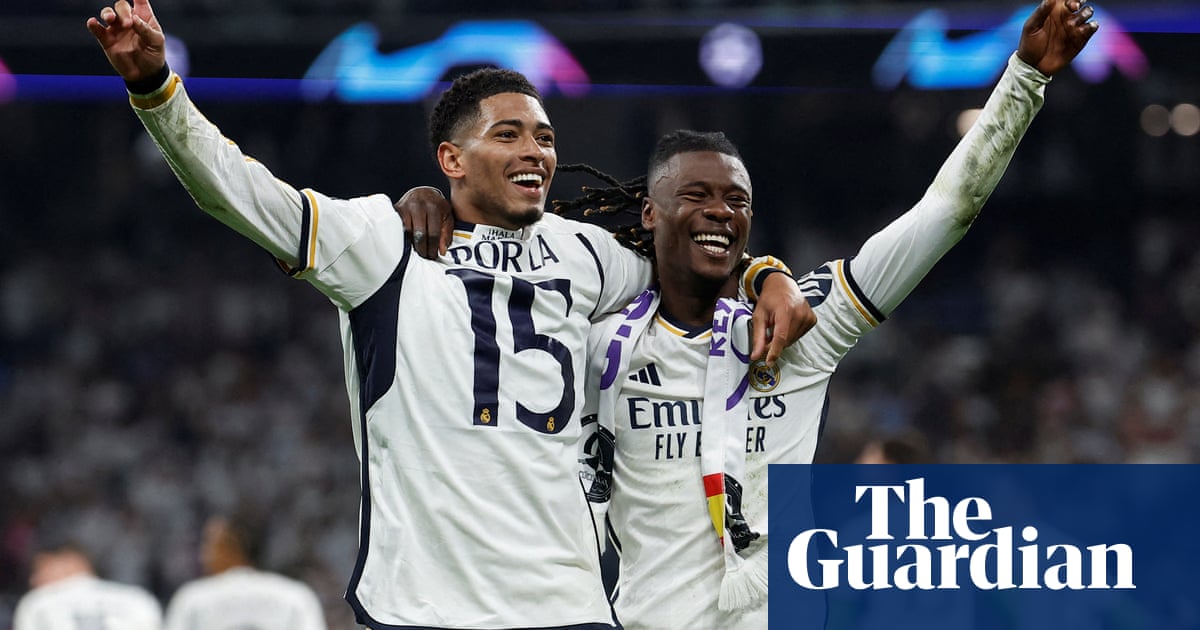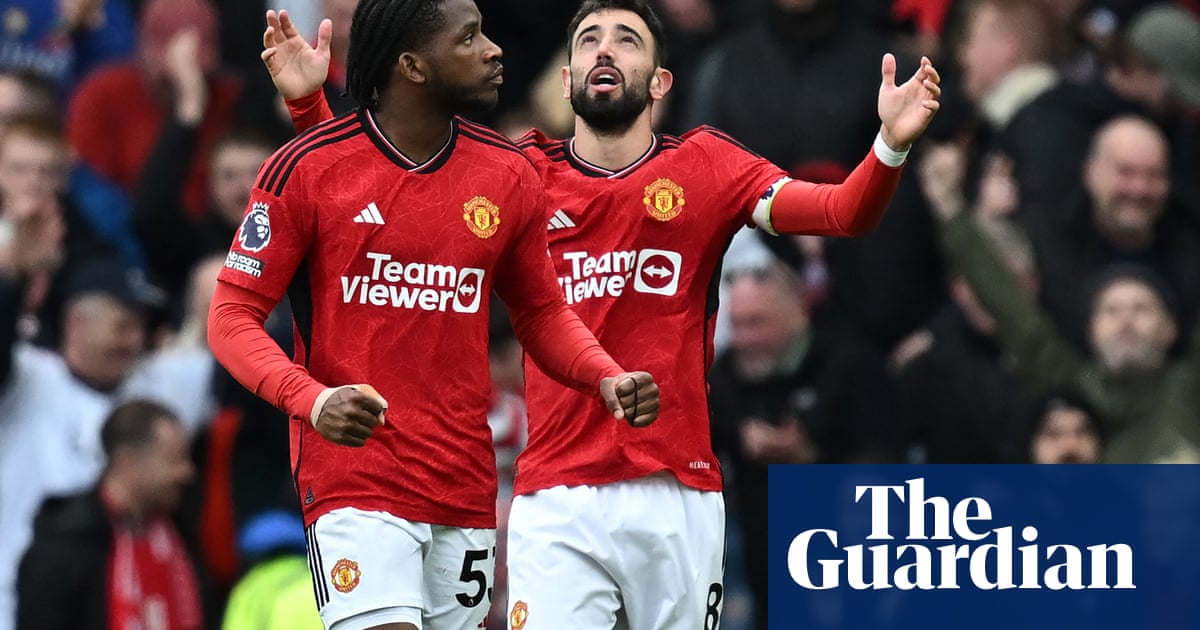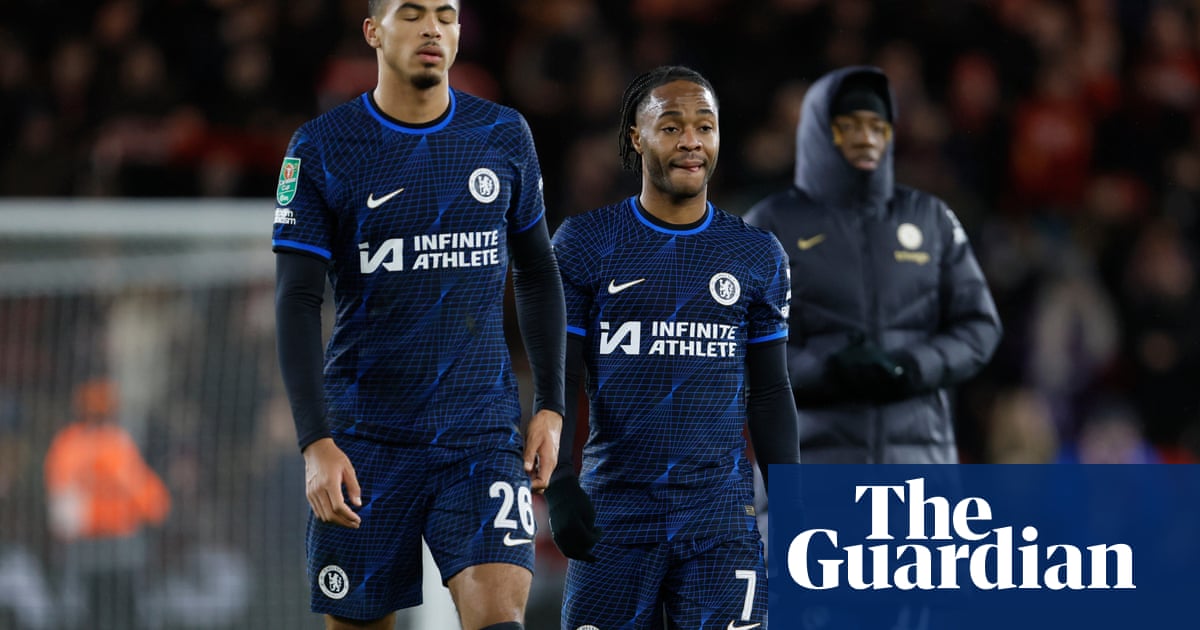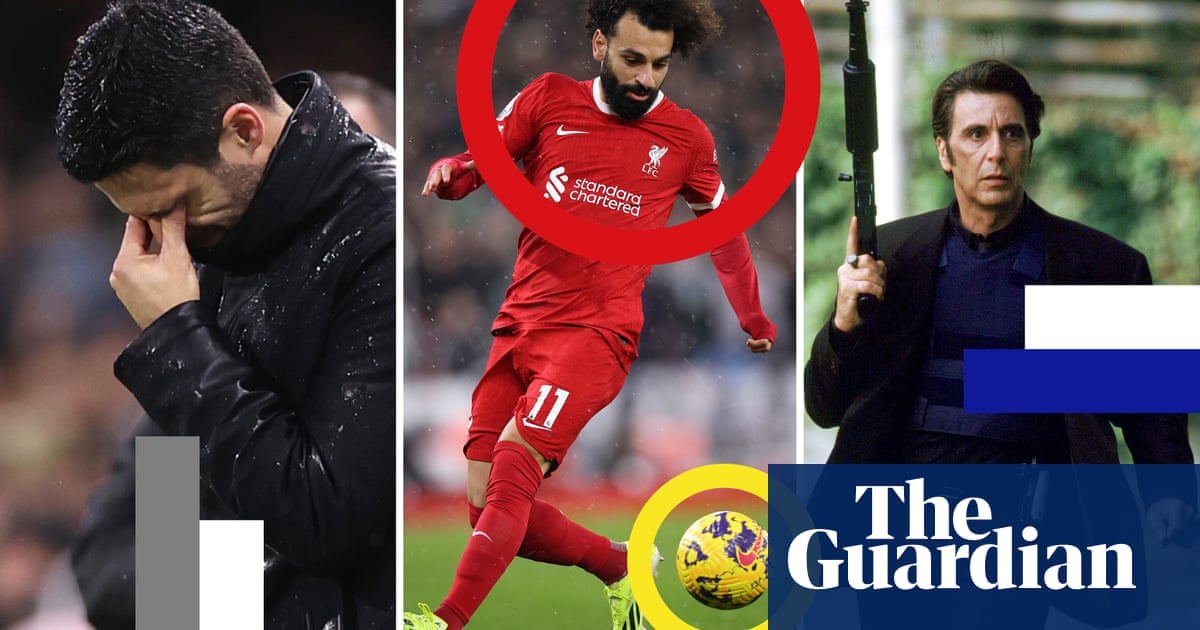
Gulp-inducing performance of the week
The holiday period was critical for Mikel Arteta and Arsenal. With Manchester City off at the Club World Cup, they had a chance to put some distance between themselves and Pep Guardiola’s side before the turn of the year. It was their biggest title test of the season so far – and they failed.
Everything about Arsenal feels arrhythmic and stilted these days. The forwards are not combining cleanly. When they create openings, neither Gabriel Jesus nor Eddie Nketiah has proved to be clinical in front of goal. They’ve taken one point from a possible nine in their last three games. Their performance against West Ham, for spells, was fine, they just couldn’t fashion a finish. Against Fulham this weekend, though, they were outplayed for large stretches, just as they were against Liverpool at Anfield.
A ton of online ink has been spilled on the need for a proven, penalty-box goalscorer. But their issues extend beyond that. Without Oleksandr Zinchenko in the lineup, Arsenal struggle to create as effectively from out to in, the kind of combinations that flowed effortlessly last season. With Zinchenko in the lineup, they’re vulnerable defensively.
Arteta has struggled to find the right balance between his midfield three and how to effectively deploy his left-sided fullback for the bulk of this season – and how that dovetails with Gabriel Martinelli as the left-sided forward. Using an inverted fullback to drag the pieces closer together makes sense when it’s Zinchenko, a midfielder in defender’s clothing, but when Arteta turns to Jakub Kiwior or Takehiro Tomiyasu, the reasoning becomes muddied.
In the 2-1 defeat to Fulham, Arsenal were rigid going forward and too loose once they turned the ball over. They conceded more shots (15) than they have in any other Premier League game this season. Fulham consistently cut Arsenal apart on the counter, which is kind of, sort of the whole point of sliding a fullback in the middle of the pitch to begin with. Just as concerning: for the first time in 18 months, Bukayo Saka and Martinelli are struggling at the same time.
Arteta’s side enter 2024 fourth in the table, only one point ahead of Tottenham. Finding a natural goalscorer will dominate the conversation throughout January, but Fulham proved the manager has concerns that need addressing all over the pitch.
Goal of the week
Some goals are special because they feature a free-flowing, tippy-tappy team move. Others jump off the screen because they’re a thunder[REDACTED BY EDITOR]. And then there are magical moments like this from Michael Olise in Crystal Palace’s 3-1 win over Brentford.
Oof. Can someone point me to the showers? There is just something about the way Olise moves. It’s as though he’s stumbling while levitating; grace and ruggedness. He seems to cram in three moves when to the humans among us only one is available. In a world of pre-programmed attacking routines and robotic forwards, Olise is a genuine artist. And he’s adding more substance to his style, racking up four goals and an assist in his last four games.
The underlying metrics are even more impressive. Among eligible forwards this season, Olise ranks fourth in xGChain per 90 and fifth in xGBuildUp per 90, measures of a player’s creative impact. Most importantly: his dribble and finish against Brentford measured a whopping 11.7 on the how-did-he-do-that scale.
Olise’s performance this weekend was his most impressive and important to date, ending a Crystal Palace run of eight league games without a win. For now, it should ease the pressure on Roy Hodgson, though the specter of Steve Cooper continues to linger. Regardless of who manages the club over the second half of the season, Olise will remain the focal point, so long as Palace can fend off the January transfer vultures.
The Michael Scott award for hapless management
There seems to be this general sense in the football culture that Manchester United are inconsistent. But what, exactly, is inconsistent about being consistently awful?
Saturday’s defeat against Nottingham Forest on Saturday meant United lost 14 games before 31 December for the first time since 1930 … which just so happened to be the year of the Great Depression.
The most depressing thing: the 2-1 defeat to Forest was all so predictable. Lethargic in their buildup play. Passive to the point of derision without the ball. It had all the defining hallmarks of United sides over the past eight-odd years bundled into 90 minutes.
There is no cohesion to United’s play minute-to-minute or week-to-week. They have no discernible style of play. The fleeting moments of exuberance from Alejandro Garnacho serve only to remind you how insipid Marcus Rashford, Bruno Fernandes and Antony have been for the other 80-plus minutes.
Most puzzling of all: Erik ten Hag’s continued insistence on featuring Scott McTominay. A back-of-the-notepad accounting will tell you that United have conceded the same goal roughly 8,000 times in the post-Ferguson era. There is a scattered press upfront, the opposition bursts through the first line of defense, cutting out three forwards and a pair of midfielders, a holding midfielder is stranded on his own, the ball works its way out to the wing, the holding midfielder steams off, an opposition midfielder meanders into the space vacated by United’s sitter, then claps with glee as the ball is pulled back to him in oceans of space.
Both goals from Nottingham Forest fit the typical pattern. Blame was attributed to the scattered defensive line held by Jonny Evans and Raphaël Varane – including from Ten Hag himself. Kind commentators pointed to the duo’s lack of playing time together. Ordinarily, that reasoning/excuse (delete as applicable) would be fair. But not for this United team. As it has been for years, the problem falls on the lack of a defensive shield screening in front of the central defensive pairing.
The ‘Wait, are we still doing this?’ moment of the week
Let’s stick with United. Few players have been as woefully miscast over the past two decades as McTominay. That is not, of course, McTominay’s fault. The Scottish midfielder has, for too long, been asked to play the role of a rah-rah midfield mauler. He’s gravitated over time from an energizing midfield sitter into more of a box-to-box crasher. Every United manager has leant on him when they need some oomph from their flailing squad. He shows up. He tries. At most clubs, those attributes would be the minimum requirements. For United, they’re not. And so Scotty keeps getting runout after runout as successive managers clamour for some show of fight.
This season, McTominay has routinely shifted closer to what should be his natural habitat: playing off the shoulder of a frontman and serving as a penalty box poacher, delivering a couple of crucial goals as United fight through another rudderless period. But Ten Hag has been afraid to fully embrace McTominay’s metamorphosis, insisting on trotting out the Scottish international as a midfielder. Has Michail Antonio’s growth taught us nothing?
McTominay is not a midfielder; he’s an old-fashioned target man. He was misidentified at a young age as the heir to Darren Fletcher or Michael Carrick, a tall, cerebral midfielder who could break up play and keep the ball circulating. But McTominay has never rounded into that kind of player, instead relying on his physicality. There is no guile to go with his grit.
Ten Hag refuses to give up on the possibility that a 27-year-old McTominay could evolve into something in midfield, despite the evidence of his eyes and ears.
For some reason, clubs find it nigh-on impossible to acknowledge they have misevaluated a player’s position at a young age. What are the odds that the bulk of players were playing in the ideal role by the time they were 16?
The Forest defeat offered another damning indictment of Ten Hag’s in-game management and player identification. Sliding McTominay into the base of midfield coughed away any semblance of balance or control United had in the middle of the pitch – again.
Ten Hag removed the tactically astute Kobbie Mainoo at half-time with the game dawdling along at 0-0 in favor of McTominay. He pointed to the 18-year-old playing a third game in a week (fair), before explaining that his side was better in the second half (incorrect). “I don’t regret [the substitution],” Ten Hag said. “I thought Scott, he brought energy, I think second half was much better [from] our side.” There, in a sentence, is the McTominay conundrum. He. Brought. Energy. What else he brings in midfield at this point is anyone’s guess.
Player of the week
We got the full Mohamed Salah experience against Newcastle on Monday in Liverpool’s 4-2 win. Liverpool peppered the Newcastle goal in the first half to no avail, wasting a hatful of excellent chances. Salah was at times frenetic and wasteful, missing a key chance and a penalty.
In the second half, however, he was at his marvellous best. Salah finished the game with two goals and two assists, helping drive Liverpool to the biggest expected goals haul in the history of the metric.
Liverpool’s title bid runs through their talismanic forward. In total this season, Salah tops the Premier League charts in [deep breath]: goals and assists; expected goals and assists; shots on target; big chances scored; big chances created; open-play chances created; touches in the opposition box.
How Liverpool navigate the next month while Salah is playing for Egypt in the Africa Cup of Nations will be crucial. For all the talk of defensive vulnerabilities and a remodelled midfield heading into the season, it’s been the lack of cutting edge in the final third that has undercut Liverpool’s credentials so far. Jürgen Klopp will be hoping the other forwards can keep the team’s head above water until Salah returns.
The Vincent Hanna ‘What are these guys looking at?’ award
There’s a moment midway through Heat where Lt Vincent Hanna realizes what he’s up against. Neil McCauley isn’t your common variety bank robber. “Is this guy something?” the cop says after surveying McCauley’s work. “This crew is good.” To catch an uncommon criminal, Hanna knows he has to do things differently.
Maybe this is a case of being stuck in a bubble, but the bulk of praise for outperforming preseason expectations this season has fallen (rightly) on Unai Emery at Aston Villa and the Fighting Sean Dyches. But what about the job Gary O’Neil is doing at Wolves? No one is squeezing out more with less than O’Neil and his staff. And he’s done it by operating differently.
O’Neil has done a deft job of toggling lineups and styles, building one-off gameplans to attack opponents’ weaknesses. Listen closely enough as kick-off approaches and you can probably hear O’Neil marching around the locker room, Hanna-like. Whenever those guys walk out of that door, whatever three points they think they’re gonna take next, they’re gonna have the surprise of a lifetime.
Wolves have logged 50 minutes or more in seven different shapes this season. They’ve been malleable against whoever they’re facing, bouncing between three or four looks in a given half. O’Neil has also deftly deployed a variety of pressing “traps” to help spring transition attacks. On counterattacks this season, Wolves are averaging 0.15 xG per shot, the fifth-fattest mark in the league, according to StatsBomb. They don’t create a ton of chances, but they create valuable ones.
In case you’ve forgotten, O’Neil took the Wolves jobs two days before the start of the season. Julen Lopetegui walked out after a disagreement with the club’s owners on transfer policy. Seventeen players left the club, including captain Rúben Neves. The scent of a relegation battle was wafting throughout the halls of Molineux.
Now, Wolves are 11th in the league, only a point behind Chelsea and two points behind Newcastle – and this in a season where they’ve been on the wrong side of a number of VAR and officiating decisions. It will be a tight manager of the year race, but O’Neil should be at the front of the pack.




